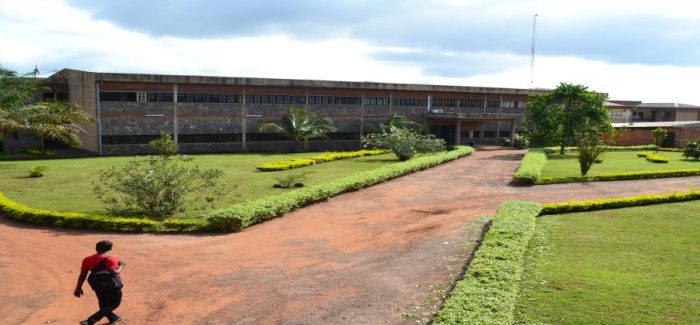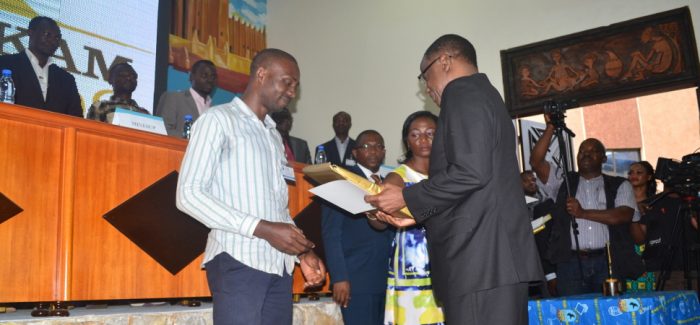KFokam Journal of Applied Science & Technology - Inaugural Edition
Effect of Single Superphosphate and Arbuscular Mycorrhizal Fungi on Growth and Bambara groundnut (Vigna subterranea (L.) Verdc.) Yield
TEMEGNE NONO Carine1*, GOUERTOUMBO Willy Franz1, NKOU FOH Dalida1, WAKEM Germaine-Alice1, NTSOMBOH-NTSEFONG Godswill1,3, Atabong Paul AGENDIA1, TAFFOUO Victor Desiré2, YOUMBI Emmanuel1
1Department of Plant Biology, Faculty of Science, University of Yaounde I, P. O. Box 812 Yaounde, Cameroon.
2Department of Plant Biology, Faculty of Science, University of Douala, P. O. Box 24157 Douala, Cameroon.
3Department of Valorization and Innovation, Institute of Agricultural Research for Development, P. O. Box 2123 Yaounde, Cameroon.
*corresponding author: nonocarine2003@yahoo.fr
Abstract
The aim of this study was to reduce food insecurity by improving the yield of Bambara groundnut with phosphorus fertilizer. The experiment was carried out in the field at the University of Yaounde I. The experimental design was a split plot with three factors; landraces (V1 and V2), single superphosphate doses (0, 50, 100, 150 and 200 kg P2O5.ha-1) and AMF inoculum (M0: -AMF and M1: +AMF). P2O5 doses and AMF (composites Gigaspora margarita, Acaulospora tuberculata and Glomus intraradices) significantly boosted growth (number of branches, shoot height) and yield of Bambara groundnut. The dose 150 kg P2O5.ha-1 significantly increased the yield by 100% compared to the control (0 kg P2O5.ha-1+M0) in V1. AMFs significantly increased the yield by 87.5% compared to the control in V2. P2O5 and AMF independently improved the grain yield. However, low doses of P2O5 (100 kg.ha-1) may be associated with AMF to maximize grain yield of Bambara groundnut.
Les nouvelles guerres industrielles
Hakim Ben Hammouda
A decentralized strong authentication access system based on rfid, face recognition and raspberry pi
SWI Innocent CHE*, LIENOU TCHAWE Jean-Pierre †
*The University of Dchang, Faculty of Sciences, department of Mathematics and Computer Sciences swiinnocent@gmail.com; 679455723
†The University of Bamenda, HTTTC/Coltech, lieanou@gmail.com, 699590924
ABSTRACT: Access to most secure areas is controlled with use of mechanical lock and key. The objective of this paper is to design a secure door access system using face recognition, raspberry pi and RFID, with capability of data collection and treatment. In this paper, we present three sub-systems that is a system to read, write and protect data on RFID card using raspberry pi and RC522, (The face recognition module has been successfully tested on students attendance) then a decentralized secure access system using the above components with the single addition of a stepper motor which functions as an actuator, finally a web platform to remotely access user data log. Radiofrequency identification (RFID) is a technology that uses radio waves to transfer data from an electronic tag, called RFID tag or label, attached to an object, through a reader for the purpose of identifying and tracking the object. In our case, it is used to identify a person. When the holder of the tag places the card near the reader, the information is read and cross-referenced in the database for authenticity. If the information is validated, then the door opens and the data timestamped and saved in a local and online server, else the door remains locked. Using RFID tag is more accurate than other biometric means of its high authentication because of its accuracy of detection.
Keywords: RFID, Raspberry pi, RC522, stepper motor, biometric data.
Isolation of a pentacyclic triterpenoid from Sceletium tortuosum
Itumeleng B.Setshedia*, Martin Myera, John Dewara and Gerda Foucheb*
a College of Agriculture and Environmental Sciences, University of South Africa, Florida Park, Johannesburg, Gauteng, South Africa
b Department of Chemistry, University of Pretoria, Hatfield, Pretoria, Gauteng, South Africa
Corresponding authors: u04588313@up.ac.za; itu.sets@gmail.com
Abstract
Traditionally, extracts from Sceletium tortuosum have been used, both as a medicine as well as for social and spiritual purposes. The genus is distributed in the south-western parts of South Africa. Methanolic extracts of S. tortuosum were prepared and fractionated using column chromatography. Indole alkaloids have been reported from S. tortuosum with mesembrine as the most abundant alkaloid and mesembrenone, 4’-odemethylmesembrenol and tortuosamine also present. A triterpenoid, novel to this genus was isolated and reported for the first time. NMR and HPLC-MS/MS analyses were used to confirm the structure of the compound.
Key words: Sceletium tortuosum, alkaloids, triterpenoid, obtusalin.
Factors affecting the global diffusion of an African animal genetic resource: the case study of the Cameroon Blackbelly sheep
Meka zibi II. M.A*., Meutchieye. F*., Ntsoli. J., Tadakeng Y., Fonteh .F
Department of Animal Science, FASA; University of Dschang P.O. Box 188, Dschang Cameroon
* Authors for correspondence: fmeutchieye@univ-dschang.org ; mekaarthur@yahoo.ca
Abstract
Sheep farming is a vital component in the food, economic and socio-cultural security of many countries around the world. Sheep are present in most countries of the world, proving their adaptation capacities to different climatic conditions and agro-ecological zones in different countries. Because of these capabilities, they have been widely disseminated in order to enhance their genetic potential. Several elements have contributed to the diversification and dissemination of this biodiversity, including the human slave trade waves. During these movements, Cameroon ovine biodiversity has been exported and distributed throughout the world, particularly the Blackbelly sheep breed. Within the framework of the World Action Plan focusing on the characterization of native biodiversity, it is important to trace the dispersal routes and models of this particular breed across the world in order to demonstrate the impact of slave trade in the dissemination of animal material, but also to collect information on the ways of adaptation and exploitation of the Blackbelly sheep around the world. This could enable the conservation and better improvement of this genetic resource in Cameroon for the benefit of population. From publications collected on the matter around the world, it appears that slave trade and the triangular trades were the main factors of global diffusion of the Cameroon Blackbelly sheep. The Blackbelly has been spread in two continents: America and Europe, but its main settling area was the Caribbean. The Barbaric Island was the main point of adaptation of this breed hence the name Barbados Blackbelly from which several countries have refueled. The Blackbelly sheep has been adopted as an official breed after improvement in 4 countries: Barbaric Island (Barbados Blackbelly), the United States (American Blackbelly), Germany (Kamerun Schafe), and in Martinique (Martinik Sheep). All these varieties share some specific features that have remained very close to that of the sheep of Cameroon notably: the brown coat color with a blackbelly, resistance to diseases (trypano-tolerant), hardy, and prolific. Worldwide, the Blackbelly sheep is exploited for meat, leather, prestige, ecotourism and milk in some extent. The current state of information on Blackbelly in Cameroon is limited to descriptive study and some phenotypic assessment. In-depth studies on its mode of exploitation and its molecular genetics will certainly allow better understanding of this breed to plan for methods of conservation and sustainable improvement.
Key words: Blackbelly sheep, colonization, international trade, biodiversity, Cameroon
The 3D printing of moulds used in injection moulding processing
Brando Okolo
Apium Additive Technologies GmbH – Siemensalle 84, Karlsruhe D76187, Germany
brando.okolo@apiumtec.com
Abstract
The possibility of using additive manufacturing methods such as 3D printing for the fabrication of moulds used in injection moulding processing has been discussed in this report. Two case studies depicting the benefits and draw-backs of such a fabrication approach for moulds are presented. The role of materials in creating engineering advantage for the performance of 3D printed moulds is also presented. The case studies showed that there is significant economic value in using 3D printing to fabricate moulds for small series runs on injection moulding machines rather than using moulds fabricated from milling methods.
Keywords
3D printing, additive manufacturing, injection moulding, carbon fibre, PEEK
Preserving Cameroon’s Cultures and Traditions (CAMCT) Using App and Cloud Computing
Rochelle Pacio, Nelly-Anne Shurri Ndikum, Russelle Steranova Kenge
Department of Computing and Software Engineering, KFokam Institute of Excellence; Yaounde, Cameroon
rochellepacio@pkfinstitute.com, anneshurri@gmail.com, kengnesteranova@gmail.com
ABSTRACT
In today’s world, people are addicted to their mobile devices due to its interactive features. Multimedia plays an important role on why people keep using their mobile technologies to gather information through the combination of text with video, animation, audio, graphic and virtual reality. This study aimed to develop an app and use cloud computing for storage. This app will greatly help in disseminating consistent information from one generation to another. Also, it will boost cultural tourism and innovate museums as tourists and locals will enjoy the use of this app while knowing everything about Cameroon. The methodology used for this study was Rapid Application Development (RAD) designed to provide quick software methodology that involves iterative development and quick construction of prototypes.
KEYWORDS
Cultures and Traditions, Multimedia Elements, Apps, Cloud Computing
Secondary metabolites from Desmodium ramosissimum G. Don (Fabaceae) and their radical scavenging properties
Raymonde A. Dzatie Djoumbissie1, Didy H. Sonfack Fozeng1, Yves M. Mba Nguekeu1, Pierre Tane1, Hiroyuki Morita2, Maurice D. Awouafack1*
1Natural Products Chemistry Research Unit, Department of Chemistry, Faculty of Science, University of Dschang, P.O. Box 67, Dschang, Cameroon
2Institute of Natural Medicine, University of Toyama, 2630-Sugitani, Toyama 930-0194, Japan
Abstract
This work was designed to carry out the phytochemical study and the radical scavenging screening of the MeOH extract from the whole plant of Desmodium ramosissimum used in traditional medicine for the treatment of malaria, fever, diarrhea, lung disorders and venereal diseases. The crude extract was subjected to silica gel open column chromatography (CC) follow by repeated silica gel CC purification and / or Sephadex LH-20 to afford nine compounds, D-pinitol (1), mixture of β-sitosterol (2) and stigmasterol (3), β-sitosterol-3-O-β-D-glucopyranoside (4), glyceryl-1-tetracosanoate (5), lutein (6), kaempferol (7), catechin (8) and vitexin (9). The structures of these compounds were identified after analysis of their NMR and MS data and comparison with the literature. The crude extract, fractions III, IV and V displayed constituents possessing radical scavenging activities using the 2,2-diphenyl-1-picrylhydrazyl (DPPH) bioautography while vitexin (9), and catechin (8) showed activity among the isolated compounds.
Keywords: Desmodium ramosissimum; constituents; Radical scavenging, Vitexin; Kaempferol
Urbanization, CO2 Emissions, and Science-Technology-Society in Cameroon
Jacob TCHE1,2*, Nana Alex Roosevelt2 , Tedonfouet N. Aliance2
1University of Yaounde II 2KFokam Institute of Excellence
jacobtch1985@gmail.com, alianceted88@gmail.com, alexroosevelt5@gmail.com
Abstract
Important advances have been made in theoretical and econometric research in the relationship between CO2 and urbanisation. However, scanty attention has been focussed on the role and importance of science and technology as one of the major factors reducing CO2 emissions. For example, to our knowledge, Cameroon has never been chosen as a case study. Therefore, the statistical and econometric analyses undertaken in this paper aims at filling this gap. We begin our analysis by employing statistical tools and econometric tests such as unit root tests, Cointegration tests, Error Correction tests and the Granger short and long run causality tests. Our results related to the causal relationship between CO2, urbanization and science and technology indicate that while there is a bidirectional causality between the latter variables in the long run, there is no causality between the studied variables in the short run.
Keywords: Urbanization, CO2 emissions, science and technology and ecological modernization













